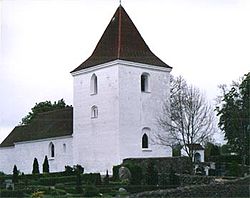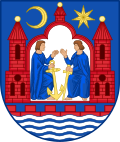Mårslet
Mårslet | |
|---|---|
Town | |
 Mårslet Church | |
| Coordinates: 56°04′05″N 10°09′40″E / 56.06806°N 10.16111°E | |
| Country | Denmark |
| Region | Midtjylland |
| Municipality | Aarhus |
| Foundation | pre-history (unknown) |
| Railway town | 1884 |
| Part of Aarhus Municipality | 1970 |
| Area | |
| • Urban | 2.31 km2 (0.89 sq mi) |
| Population (1. January 2025) | |
| • Urban | 5,174 |
| • Urban density | 2,200/km2 (5,800/sq mi) |
| • Gender [1] | 2,510 males and 2,664 females |
| Time zone | UTC+1 (CET) |
| • Summer (DST) | UTC+1 (CEST) |
| Postal code | 8320 |
| Area code | (+45) 86 |
| Website | www |
Mårslet is a town in Aarhus Municipality, located approximately 11 km (6.8 mi) south of the city of Aarhus in the Central Denmark Region. As of 1 January 2025, it has a population of 5,174.[2] Originally a rural village, Mårslet has developed into a commuter suburb of Aarhus, supported by a light rail connection and significant residential expansion in recent decades.
History
[edit]
Mårslet was first recorded in 1360 under the name Mordslet, a compound possibly derived from the Old Danish word marth (meaning either "marten" or "forest") and slet ("clearing"). The name thus likely refers to a woodland clearing.[3]
Historically, the settlement developed as an irregular roadside village (vejforteby) in a small valley through which the Giber Å stream flows. Early farmsteads were located southeast of the church and along Lindegårdsvej to the southwest, and elements of the original street layout remain visible today.[4]
The parish church, located on a hill north of the stream, dates from the Romanesque period and contains a well-preserved set of wall paintings from around 1200.[5]
Significant development began in 1884 with the construction of the Hads-Ning Herreders Railway (later the Odder Line), which included a station in Mårslet. The improved connectivity spurred residential expansion, particularly around 1900, when red-brick houses with decorative masonry were built along Tandervej and nearby streets.[6]
Mårslet functioned as an independent parish municipality until the 1970 Danish Municipal Reform, when it was merged into Aarhus Municipality. From the 1960s onward, the town experienced substantial suburban growth, with the development of large single-family housing estates.
In 2018, the Odder Line was incorporated into the Aarhus Letbane light rail system, improving public transport links to central Aarhus.[7]
Demographics and housing
[edit]Mårslet has one of the highest average household incomes in the East Jutland metropolitan area.[8] The population has grown considerably in recent decades, driven by migration from Aarhus and a high level of new housing construction. The town includes a variety of housing types, primarily detached single-family homes.
Transport
[edit]Mårslet is served by the Aarhus Letbane light rail system, which provides a travel time of approximately 25 minutes to Aarhus city centre. Bus 16, operated by Busselskabet Aarhus Sporveje, offers an alternative route with a travel time of around 30 minutes. Increased commuter traffic has led to congestion issues in the town centre during peak hours.[9]
Culture and sport
[edit]Mårslet Fællesråd (Mårslet Joint Council) is an umbrella organisation for local associations and acts as a liaison between residents and Aarhus Municipality.[10] The council maintains the town website and contributes to the local monthly magazine, Mårslet-Bladet, which is produced on a volunteer basis.
Mårslet's main sports club is TMG (Testrup Mårslet Gymnastikforening), which offers activities in football, handball, gymnastics, basketball, volleyball, badminton, tennis, darts, pétanque, and fitness training.[11] The club's senior football team achieved notable success in 2007 by winning the JBU Cup as the lowest-ranked team in the tournament's history,[12] and in 2016 earned promotion to the seventh tier of Danish football.[13]
Notable people
[edit]- Claes Antonsen (born 1963), drummer
- Mads Larsen (born 1973), super middleweight boxer
- Michelle Brandstrup (born 1987), handball player
References
[edit]Bibliography
- Frandsen, Karl-Erik (1983). Vang og tægt : studier over dyrkningssystemer og agrarstrukturer i Danmarks landsbyer 1682-83. Esbjerg: BYGD. ISBN 87-87293-25-0.
- Pedersen, Henrik (1975). De danske Landbrug : Fremstillet paa Grundlag af Forarbejderne til Christian V's Matrikel 1688 (Reprotryk ed.). Kbh.: Landbohistorisk Selskab. ISBN 87-7526-056-5.
Notes
- ^ BY1: Population 1. January by urban areas, age and sex The Mobile Statbank from Statistics Denmark
- ^ BY3: Population 1. January by urban areas, area and population density The Mobile Statbank from Statistics Denmark
- ^ "Mårslet". Lex (in Danish). 15 May 2017. Archived from the original on 29 November 2024. Retrieved 28 July 2025.
- ^ Bendsen, Jannie Rosenberg (1 November 2019). "Mårslets arkitektur" [The Architecture of Mårslet]. Trap Danmark | Lex (in Danish). Archived from the original on 13 June 2024. Retrieved 28 July 2025.
- ^ "Mårslet Kirke – Ning Herred" (PDF). Danmarks Kirker (in Danish). Archived from the original (PDF) on 28 July 2025. Retrieved 28 July 2025.
- ^ "Mårslet Letbanestation (Mst)". Danske Jernbaner (in Danish). Archived from the original on 24 April 2025. Retrieved 28 July 2025.
- ^ "Letbanens historie" [The history of Letbanen]. Aarhus Letbane (in Danish). Archived from the original on 11 July 2025. Retrieved 28 July 2025.
- ^ Juul, Jonas Schytz (19 February 2017). "De rigeste områder slår rekord, mens de fattiges indkomst falder" [Richest areas hit record highs as poorest see incomes fall]. Arbejderbevægelsens Erhvervsråd (in Danish). Archived from the original on 17 February 2025. Retrieved 28 July 2025.
- ^ Rysgaard, Kåre Kildall (13 May 2017). "Nordhavn, Mårslet og Aarhus: Her er de områder, som nye indbyggere strømmer til" [Nordhavn, Mårslet and Aarhus: where new residents are flocking]. DR (in Danish). Archived from the original on 28 December 2024. Retrieved 28 July 2025.
- ^ "Om Mårslet Fællesråd – Maarslet.nu". Maarslet.nu (in Danish). Archived from the original on 26 April 2025. Retrieved 28 July 2025.
- ^ "TMG". TMG Sport (in Danish). Retrieved 28 July 2025.
- ^ "DBU Jyllands Ungdomspokalturnering". DBU (in Danish). Archived from the original on 10 July 2025. Retrieved 28 July 2025.
- ^ "Vi fejrer oprykning til serie 2 på lørdag!" [We're celebrating our promotion to Division 2 this Saturday!]. TMG Fodbold (in Danish). 26 October 2016. Archived from the original on 28 July 2025. Retrieved 28 July 2025.
| Preceding station | Aarhus Letbane | Following station | ||
|---|---|---|---|---|
| Vilhelmsborg towards Odder
|
Line 2 | Mølleparken towards Lisbjergskolen or Lystrup
| ||



